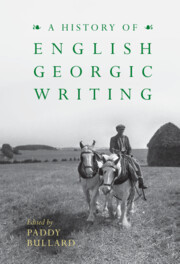Book contents
- A History of English Georgic Writing
- A History of English Georgic Writing
- Copyright page
- Contents
- Contributors
- A Note on National Designations
- Abbreviations
- Introduction
- Part I Turnings
- Part II Times
- Part III Territories
- Chapter 13 Low Lands
- Chapter 14 Between the Georgic and the Pastoral
- Chapter 15 American Georgic
- Chapter 16 Environment and Empire
- Bibliography
- Index
Chapter 15 - American Georgic
from Part III - Territories
Published online by Cambridge University Press: 01 December 2022
- A History of English Georgic Writing
- A History of English Georgic Writing
- Copyright page
- Contents
- Contributors
- A Note on National Designations
- Abbreviations
- Introduction
- Part I Turnings
- Part II Times
- Part III Territories
- Chapter 13 Low Lands
- Chapter 14 Between the Georgic and the Pastoral
- Chapter 15 American Georgic
- Chapter 16 Environment and Empire
- Bibliography
- Index
Summary
This chapter examines representations of American land and labour in the late nineteenth century as a complex engagement with the georgic mode. US writers used georgic representations of economic, technological and imperial expansion to promote widely divergent visions of the ideal citizen and worker, from the virtuous husbandman of Thomas Jefferson’s Notes on the State of Virginia (1785) to the bean-hoeing intellectual of Henry David Thoreau’s Walden (1854). Although the georgic mode represents themes central to US cultural history, it is not merely a celebration of industry and labour; like Virgil’s Georgics, which holds out the promise of progress in a fallen world but shows the human and environmental costs of the hard work it seems to promote, US adaptations of georgic illuminate the destructive aspect of agricultural labour and the moral ambiguities of imperial expansion and racialized labour.
Keywords
- Type
- Chapter
- Information
- A History of English Georgic Writing , pp. 316 - 343Publisher: Cambridge University PressPrint publication year: 2022

